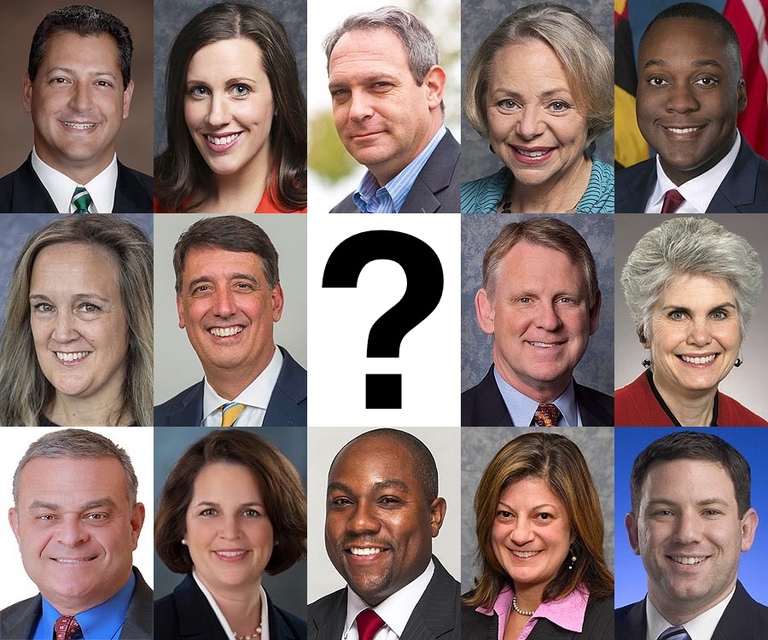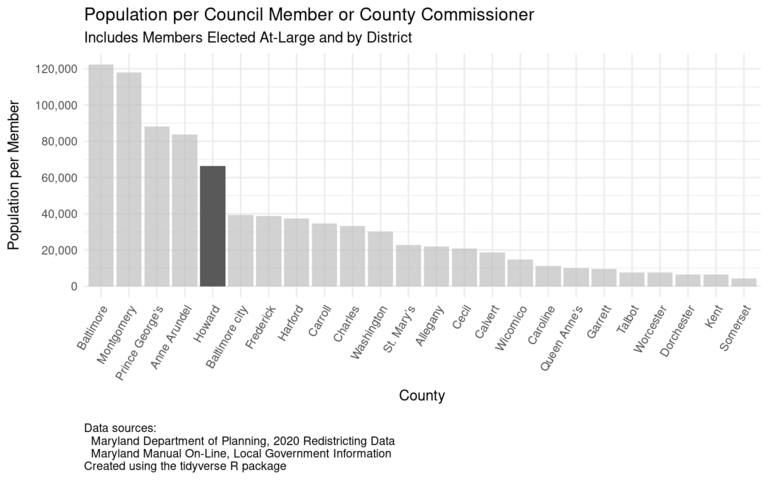tl;dr: Let’s expand the Howard County Council to make it more responsive to the larger population it now serves.
[This is part 1 of a seven-part series. See also part 2, part 3, part 4, part 5, part 6, and part 7. I also wrote a follow-up post that can be viewed as an alternative to part 5.]
Howard County is too big for its county council

What might a fifteen-member Howard County Council look like? Which local political activists might run and be elected? Pictured are the last fourteen Howard County Council members, some of whom went on to hold other offices (from upper left): Greg Fox, Christiana Rigby, Jon Weinstein, Deb Jung, Calvin Ball, Liz Walsh, Guy Guzzone, Allan Kittleman, Mary Kay Sigaty, David Yungmann, Courtney Watson, Opel Jones, Jen Terrasa, and Ken Ulman. (Click for a higher resolution version.) Images from the Maryland State Archives.
For over fifty years now Howard County, Maryland, has been governed by a five-member county council and a county executive.1 In those fifty years Howard County has grown from about sixty thousand people to well over three hundred thousand, more than five times as many people as when its first county council was sworn in.
In 2019 the Howard County Charter Review Commission recommended expanding the size of the county council from five members to seven. This was a relatively minor change, but one which seemingly did not attract any support from the county executive, the county council, or—for that matter—anybody else. So why am I writing about this topic now?
Because I don’t think the Charter Review Commission was being bold enough in its recommendations. Even I wasn’t being bold enough in my previous post recommending a move to ranked choice voting for either a five- or seven-member council.
I believe that the structure of the County Council needs a more thoroughgoing reform in order to bring it closer to the people of Howard County, better reflect the preferences of county voters, and potentially reduce political polarization that can bleed over into other areas, most notably the Board of Education.
So in line with the motto “go big or go home” I’m coming back with an even bolder four point recommendation:
Triple the size of the Howard County Council, expanding it from five members to fifteen.
At the same time, reduce the number of council districts from five to three, with five council members elected from each district.
Elect each district’s council members using ranked choice voting, in which each voter would list the candidates they want to see elected, in order of preference.
Establish a nonpartisan commission to draw the district lines using a process that takes into account various criteria important in redistricting—creating compact and contiguous districts with equal populations, not diluting the voting power of minorities, and ensuring competitive races not marred by partisan gerrymandering—with all code, data, and background assumptions made publicly available.
In this post I address the first part of this proposal, namely expanding the Howard County Council.
Why fifteen council members?

The population per council member or county commissioner for each Maryland county and Baltimore city. (Click for a higher resolution version.) Graph by Frank Hecker; made available under the terms of the Creative Commons CC0 1.0 Universal (CC0 1.0) Public Domain Dedication.
Why expand the Howard County Council? First, to provide better service to county residents. When the Howard County Council was first established there was one council member for every twelve thousand people or so. Now each council member serves almost seventy thousand people, a number that makes it more difficult for a council member to attend to the needs of any given constituent.
As the graph above shows, Howard County is in the top five of Maryland juridictions when it comes to population per council member or county commissioner. The average ratio for all Maryland counties and Baltimore city is thirty-six thousand people per member. The median ratio is twenty-two thousand people per council member. (Half of all counties have a higher ratio than the median, and half a lower ratio.)
Note that Baltimore city, despite having a population considerably larger than Howard County, has a ratio of population to council member that is significantly lower than Howard County. That’s because Baltimore city has a fifteen-member city council, compared to Howard County’s five-member county council.
How big should the Howard County Council be? Increasing the council by only two members, as the Charter Review Commission recommended, would in my opinion just be putting a bandage on the problem without really solving it. On the other hand, if we wanted to keep the ratio of constituents to council members the same as in the late 1960s we’d need a council of twenty-five to thirty members. That’s a lot: I’m not sure the council chambers in the George E. Howard building has enough room to hold that many council members.2
Let’s consider an intermediate approach, increasing the size of the Howard County from five to fifteen members to match the size of the Baltimore city council. That would lower the ratio of population to council members from the current sixty-six thousand to a third of that value, or twenty-two thousand people per council member. This would match the current median value for Maryland, and be comparable to the ratios for St. Mary’s County and Allegany County.
Of course Howard County is still growing in population, so this ratio would degrade over time. However a fifteen-member council should be large enough to suffice for most if not all of the twenty-first century without requiring any further expansion.3
Enabling more people to serve Howard County

How many people in this room might be viable candidates for a greatly-expanded Howard County Council? Pictured is the Howard County Democrats Unity Dinner, held April 26, 2019. (Click for a higher resolution version.) Image from the Howard County Democratic Central Committee Facebook page.
Increasing the size of the Howard County Council also provides more opportunities for up-and-coming community activists and politicians to serve the county—and we have a lot more qualified candidates than there were in the late 1960s. Consider the picture above: of the many Howard County Democratic activists attending this dinner, surely more than a handful would be interested in making a future run for the Howard County Council and would make good candidates and council members.
If we have a lot more people qualified to run for elected positions but the number of positions doesn’t change, that leads to increasingly contentious, expensive, and partisan elections—something we see in the US at the national level, as more and more people compete for a limited number of Congressional seats.
The large number of qualified candidates can also lead to ostensibly nonpartisan elected positions becoming bones of partisan contention, as with the Howard County Board of Education: thwarted by the lack of openings on the Howard County Council, ambitious political activists can try to use the Board of Education as a springboard to future runs for the county council or other positions.
As a result Board of Education elections may become increasingly partisan affairs, featuring explicit party endorsements and people voting for candidates based primarily on their political affilations. Expanding the county council could help reduce this incentive.4
Let’s assume that there’s a consensus on expanding the Howard County Council, and that having fifteen council members is the desired council size. How should the county be divided into districts, and how should council members from each district be elected? That’s the subject of my next post.
For further exploration
For a discussion of the need to expand legislative bodies, in this case the US House of Representatives, see:
- “America Needs a Bigger House” by the New York Times editorial board.
- “Congress Needs to Be Way, Way Bigger” by David Litt in The Atlantic.
For commentary about increasing partisanship in Howard County Board of Education races see:
- “Will Partisan Politics Make The Howard County Public School System No Longer The Best In The State?” by Scott Ewart at Scott E Blog.
- “What’s at Stake in the Increasingly Politicized Howard County Board of Education Elections” by Jeremy Dommu at The Merriweather Post.
- “Partisan school board elections erode trust” by Robert Miller (letter to the editors of the Baltimore Sun).
For the numbers and code behind the graph above showing the population per council member or county commissioner, see “Howard County Council Expansion, Part 1.”
Howard County voters approved the county’s becoming a “charter county” with a county council and county executive in November 1968. The first council took office in early 1969 after a special election. ↩︎
However I’ll note that though a county council of 30 members does sound like a lot of people, that large a council is not unprecedented. As but one example, the city of Belfast in Northern Ireland, which has a population roughly the size of Howard County, has a sixty-member city council. ↩︎
As a back of the envelope calculation, if Howard County increases in population by roughly 10% every decade, then by the year 2100 the ratio of population per member would have increased by a factor of just of over two (1.18 = ~2.14), so the ratio of population per council member would still be well under what it is today. ↩︎
Arguably the size of the Board of Education should be increased as well, but that’s an argument for another day. Increasing the size of the BoE without first increasing the size of the County Council would only increase the incentives for partisans to seek a Board of Education seat. ↩︎